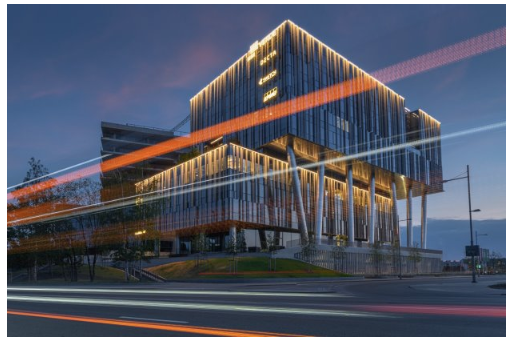New Report Finds Office Attendance in Europe’s Capitals Almost Back to Pre-pandemic Levels, While U.S. Offices Keep Losing Tenants
Several cultural factors contribute to the difference.
 European office attendance in city centers is back to pre-pandemic levels, while American offices continue losing workers. Real estate investment experts explain various reasons behind these differences.
European office attendance in city centers is back to pre-pandemic levels, while American offices continue losing workers. Real estate investment experts explain various reasons behind these differences.
A November report by Savills has found that occupancy rates in Europe’s capitals are 57%, and some days back to the pre-pandemic norm of 70%. In the U.S., on the other hand, the numbers are only at 40-60% of pre-pandemic level, and continuously dropping. According to data from Kastle Systems, in September of 2023, office badge swipes in the 10 biggest U.S. cities were at about 50% of what they were before the pandemic.
These differences are caused by various reasons - for example, the historical abundance of office space in the U.S.
“American office market was in rapid development in 1900 - 2000 (20th century), while in European cities, the faster development started only in the 21st century. Built from 1930 to 1931 and 380 meters in height, The Empire State Building is the oldest skyscraper in America that still gets into “the top 10 tallest buildings in America” list,” says “Capitalica Asset Management” investment project manager Gabrielė Gegevičiūtė.
“On the other hand, if we look at the same time period in Europe, the tallest and first skyscraper was the Boerentoren Tower in Belgium built in 1932, but only 96 meters in height. The buildings of 380 meters and higher were started to be built very recently in Europe, only in 2015. In Eastern Europe, their popularity is at its height right now, as long as they are in a city’s business center. Therefore, Europe is about 100 years behind in comparison with the USA.”
“Capitalica Asset Management” develops real estate in business centers in Eastern and Central Europe. For example, their “Verde” office complex in the business center of Riga, Latvia is 90% rented, while phase two is already 75% rented out before its completion which is scheduled for Spring of 2024.
“There's a common misconception that European offices will mimic the decline of their American counterparts. "Capitalica Asset Management" develops A-class, green, hospitable workplaces in city centers that provide a solid commuting system and a variety of amenities, to maintain a high occupancy rate,” says Gabrielė Gegevičiūtė.
Other reports confirm that the growth of modern, innovative office space in Europe is trending. “Europe will fare better than the US as remote work is less widespread, with lower vacancies in major cities. Rents for prime-grade office assets have risen within the last quarter,” says the Allianz report.
Here are some of the major trends in office space rentals comparing Europe with the U.S.
1. A need for innovative, new-generation office space. Office dwellers these days are not satisfied with just an old-style cubicle. Workland, which is housed in the "Verde” complex in Riga, has created a special environment with distinct design, bright colors, and creative corners.
“The idea is to allow people to select where they are most productive, be it at home, in the workplace, or a combination of both. Professional networking is still essential, and Workland offices are especially lively when such activities as community breakfasts are organized,” said Marju Sokman, Head of Marketing and PR at Workland.
Occupiers across the world are increasingly looking for less but leading office products, underpinned by progressive ESG credentials, proximity to amenities, and strong transport network connections, according to a JLL report.
2. Modern developments vs. old buildings. Offices in American downtown areas are generally old. For instance, 70% of properties in city centers were built 30 years ago. On the other hand, in Europe, most of them are newly built. Central Eastern European cities possess the highest proportion of newly developed commercial real estate, led by Bucharest (42%), Warsaw (34%), Budapest (30%), and Prague (27%).
Some of the reasons are connected to less restrictive planning laws and lower development costs. It is planned to develop around 4.6 million sq m of new European office spaces.
3. Commute factor: shorter in Europe. In Europe, the commute to work is shorter, and public transportation is more developed. Therefore, people tend to travel to the office more eagerly. On the other hand, in the United States, people tend to choose to stay at home because of a lack of well-working cities’ infrastructure. New York commuters have the longest average commutes in the U.S. at 58 minutes one way, followed by Chicago (57 minutes) and Los Angeles (52 minutes).
4. Europeans avoided the periphery, while Americans re-discovered suburbs. Americans are more likely than Europeans to live in the suburbs and have bigger homes, making it more appealing to work remotely. Due to remote work, American suburbs are changing, welcoming more offices, restaurants, and shops. In Europe, on the contrary, investors are avoiding city outskirts.
“It's essential to resist the allure of discounts offered on the periphery of the city,” says the manager of “Capitalica European Office Fund” Gintaras Toločka. “In Poland, Lithuania, and Latvia, where we operate, office space in central urban areas is growing, even if Western investments have temporarily slowed down, while tenants are increasingly leaving office buildings that are not central.”
“The popularity and occupancy of offices in the European city centers will only increase. The gap between the U.S. and European commercial real estate markets will continue to grow shortly,” predicts Gintaras Toločka.















